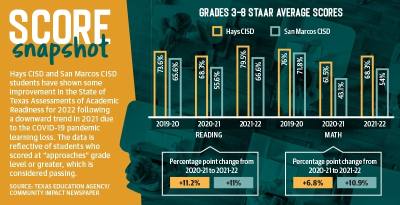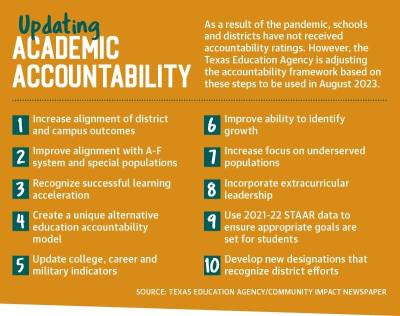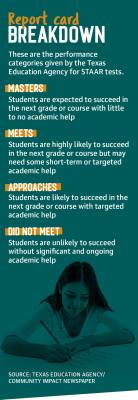“We were very pleased with the effort of our students and our teachers across the district. We did not know really what we were going to get coming out of the pandemic, still being one foot in, one foot out, and so we were not really sure how we were going to fare, but we actually did very well districtwide,” Wright said. Test scores rebounded by more than 11 percentage points from 2021.
The COVID-19 pandemic with all its waves and variants often kept kids out of the classroom and isolated, far from the support and instruction they needed to succeed, said Derek McDaniel, executive director of curriculum and instruction for HCISD.
“Even this year was not a normal year, right? We feel like it was, but if you go back and remember delta and omicron and our attendance, January and February were really unlike anything we had ever seen with the number of students out and the number of staff out,” McDaniel said.
Despite the rocky start after winter break when HCISD asked parents to substitute in classes due to a rise in cases and staff absences, teachers and students returned after spring break and put in the work that generated better STAAR test results than the previous year, McDaniel said.
“During the pandemic, a lot of the hands-on instruction that is required with math was lost,” he said.
Crunching the numbers
Both HCISD and San Marcos CISD fifth grade students showed significant improvement in their reading STAAR tests, with 2022 results surpassing 2019 results based on the “approaches grade level” performance standards outlined by the Texas Education Agency. However, the biggest weak spot both districts noticed is in math.
“Our math scores, honestly, they are lagging behind our reading scores. [In] math, we did not make as many gains as we did [in] reading,” SMCISD Chief Academic Officer Terrence Sanders said.
In 2019, 83% of HCISD students approached grade level in fifth grade math. Those results dipped to 71% in 2021 and marginally increased to 76% in 2022.
In the same subject, 78% of SMCISD students approached grade level in fifth grade math in 2019. 2021 saw a drop to 55% with an increase to 63% in 2022.
While both districts improved upon 2021 scores in 2022, neither exceeded or matched 2019 scores.
Despite the STAAR scores still not fully recovered, HCISD Director of Accountability & Testing Kevin Malandruccolo said it is still beneficial to have data the district can use to help identify learning gaps so it can meet the needs of students.
Students in seats
McDaniel and Sanders both attributed the rise in STAAR test scores from 2021-22 to students returning to the classrooms.
“It’s the lack of feedback that students receive when they are not in school. It is hard for me, as a teacher, to provide feedback and guidance when your work is done digitally,” McDaniel said. “We really got into a groove after spring break when omicron had calmed down a little bit and teachers were able to provide that feedback ... and you saw that growth.”
Despite the return to in-person instruction, both districts continue to use technology to further identify gaps in learning and knowledge.
SMCISD purchased a new software system called DecisionEd that stores districtwide data in one place, Sanders said.
“We focus so much on achievement data ... but we cannot lose sight of the other data that impacts achievement such as attendance data. We also have to make sure that we look at resource data because if we don’t have teachers in classrooms, then kids are not going to learn,” he said.
One of the biggest hurdles the districts face is the disparity of knowledge in one classroom, McDaniel said, which has only been exacerbated by the pandemic.
“As a fifth grade teacher, there were kids in my room who were on a third grade level, who were on a fourth grade level, a fifth grade level, a sixth grade level,” McDaniel said. “The range of student knowledge in your classrooms was greater than anything we had ever faced before. We always had some range, but the pandemic made it extremely broad.”
To combat that array of education levels within one classroom, blended learning and adaptive programs were used to learn a student’s strengths and weaknesses. The program then has lessons that will meet a student’s individual needs.
At the statewide level, the implementation of House Bill 4545 has also been utilized to provide additional support to students who did not pass their STAAR test. HB 4545 requires districts to provide 30 hours of one-on-one or small-group instruction over the course of the summer or following school year.
“Now that we’ve got the data on what [the students] need, we can provide that additional instruction. ... They stepped up, and they did it. They met the legal requirement, and then we saw the results of growth,” McDaniel said. “They saw the fruits of their labor come to fruition.”
Keeping the momentum
In addition to HB 4545, HCISD created a new math committee composed of teachers and administrators to address the range of knowledge. The committee met multiple times throughout the spring semester, as the district did not need STAAR test data to know that math was one of the biggest pressure points for students, McDaniel said.
Further south, SMCISD has upgraded its curriculum resources to continue the upward trajectory of scores, which is aimed at helping students with their conceptual knowledge.
“We as a district, for this upcoming year, have been very intentional at looking at the materials and resources that are being used to make sure that they are deemed high-quality. If they are not high-quality, we are not going to use them,” Sanders said.
Both districts have also implemented training and professional development to support the teachers on the ground level.
“If we do not develop our teachers and our leaders, [then] our students will not be successful,” Sanders said. “You don’t have to be bad to be better.”
New instructional documents have been created for HCISD educators to be “vertically aligned” and help go “up and down the ladder” of math, McDaniel said. The documents have been created by teachers in HCISD who are seeing, first hand, how the pandemic has hindered learning and retention.
Additionally, the new curriculum within SMCISD also goes hand in hand with the additional training that will be provided to educators with extra opportunities throughout the next school year.
McDaniel added that, while the STAAR data is not the most important tool used to measure growth, it is still useful to identify what students need. STAAR data, along with graduation rates and college, career and military readiness outcomes, are also used by the TEA when issuing accountability ratings—which have not been assigned the past two school years due to the pandemic.
“Next spring, they are moving to a new version of the A-F [rating] system,” Malandruccolo said. “It won’t be until probably next April before we know how we’ll be graded, officially.”
Campuses and districts used to receive a grade of A-F. However, as a result of Senate Bill 1365, campuses and districts will receive an A-C rating; a campus or district will receive a “not rated” rating instead of a D or F for 2022.
For the upcoming 2022-23 school year, the TEA will be updating its accountability framework and could return to an A-F scale. They will continue to update indicators of growth and desired outcomes for districts.
“If the pandemic had never happened, I don’t know if we would have changed our teaching practices as much as we have over the last [few] years,” Sanders said. “It was not something that we would have ever wished to happen, [but] it did force us to look at our practices and reexamine what we were doing. ... We’ve had the opportunity to reinvent ourselves as a result of being forced to look at what we were doing.”









